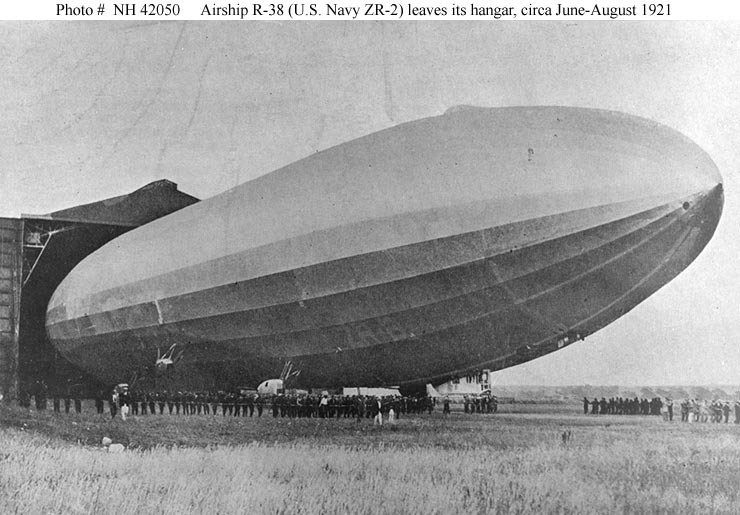Towards the end of the First World War the Admiralty ordered a Class of Airships that they required to patrol over the North Sea and provide convey protection. Four almost identical ships were envisaged. The first was to be R38. It was designed in house by the Admiralty and the contract for construction was won by Short Brothers in 1918. Due to the end of War the following three airships were cancelled and the R38 was also cancelled but after four months reinstated. As the airship base at Cardington in Bedfordshire had been nationalised it was to be built there and construction started in February 1919. The R38 was saved from cancellation as the project had been sold to the USA who wanted to to build up a fleet of airships. The price was to $2,500,000.

Plans for R38.
The specification was to be 695' long, 84' in diameter with a volume of 2700,000 cu ft providing a lift of 84 tons. She was powered by 6 engines that gave a max. speed of 71 mph. Here range was to be 6500 miles, 10500 at cruising speed. Maximum ceiling was to be 22,000 ft. She was designed to carry a 1lb gun with 24 machine guns in pairs and load 4 x 520lb and 8 x 230lb bombs, although these were never fitted.
Construction was finally completed on 7th June 1921. There had been no time to change the registration from R38 to the American ZR-2 but did have the US Insignia. The change was completed at Howden air base. The maiden flight was 23rd June 1921. She was the largest airship in the world at the time of her first flight.

Leaving for maiden flight.
There was a joint crew of British and Americans to carry out the trials and familiarisation prior to the deliver to America. During the first flight they discovered some trimming problems during a seven hour flight. The second flight was on 27th June and the trimming problems remained so they decided to reduce the size of the control surfaces.

R38 being man handled out of her hanger. ZR 2 can faintly be seen on the airship so I assume that this is at Howden after she had been painted. The hanger also looks the same as the lower photo which is Howden.
The third flight took place on 17th July and was to be to Howden airship base to the west of Hull via the North Sea. However when the speed was increased to 58mph the airship started to pitch through about 500 ft. Speed was reduced and she headed for Howden. It was found that several girders around the midships engines had failed.

R38/ZR2 in the hanger at Howden.
Poor weather meant that the next flight didn't take place until 23rd August The plan was to fly to Pulham airbase in Norfolk to carry out trials for mooring to a mast as Howden did not have one. The amount of trials were going to be reduced to speed things along so they would also be loading stores for the flight over the Atlantic to the USA after hand over. When they arrived they could not land as there was low cloud/fog so she went out over the North Sea. There was still fog the next morning so it was decided to return to Howden and carry out further trials on the way. The first trial was full speed trials and they achieved 71.9 mph. This was followed by turning trials. At the time they were at 2000 ft over the Humber Estuary just off shore from Hull Pier with thousands watching. Speed was reduced to 60 mph and the turns started. at 1737 on 24th August 1921 the crowds noticed the airship buckle in the middle and then the ends start to droop. Shortly afterwards a fire started in the forward end followed by a huge explosion that broke windows over a large area of Hull. The remains landed in the estuary. The trial crew consisted of 17 Americans and 32 British. 1 American and 4 British survived and and they were all pulled out of the water from the after section.

The wreck on the sand banks off Hull when the tide went out.

Salvage operations on the after section.
The inquiry soon afterwards found that the disaster was caused by structural failure and left it at that. R38 had been built much stronger than the previous L71 but was designed to be able to turn at high speed where as L71 was much slower. That would infer that the stresses caused by the turn had overstressed the girder system causing the collapse and escape of gas and explosion.

There is a memorial to the R38 disaster in the Western Cemetery in Hull.
No comments:
Post a Comment